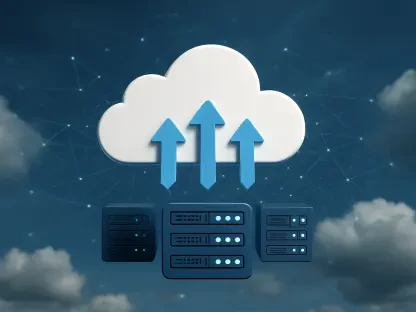In the ever-evolving landscape of IT infrastructure, Kubernetes has emerged as a dominant force in container orchestration, transforming how applications are deployed and managed across diverse environments, and with a significant milestone reached in 2024, marking a decade of innovation, it now powers production clusters for approximately 75% of organizations worldwide. This includes industry giants like Netflix, Spotify, Airbnb, and Niantic, the creators of Pokémon Go. The shift toward cloud-based clusters is striking, with 64% of these setups operating in the cloud today, a sharp rise from just 45% a few years ago. However, this widespread adoption introduces profound challenges for network operations (NetOps) and cloud operations (CloudOps) teams. The added layer of complexity, compounded by trends like cloud adoption, virtualization, and remote work, often outpaces the budgets and processes of many enterprises. Tracking application traffic across on-premises, cloud, and Kubernetes environments has become a daunting task, straining resources and expertise in ways that demand urgent attention and innovative solutions.
1. Understanding Kubernetes’ Rapid Growth and Impact
Kubernetes’ ascent as the leading container orchestration platform has reshaped modern IT landscapes, but it comes with significant hurdles for operations teams tasked with maintaining network stability. The platform’s reach is evident in its adoption by major corporations, where it underpins critical applications in production environments. This popularity stems from its ability to manage containerized workloads efficiently, yet the surge in cloud-hosted clusters—now at 64%—signals a shift that complicates network oversight. NetOps and CloudOps teams face mounting pressure as the intricacy of hybrid infrastructures grows, often without corresponding increases in IT budgets or updated workflows. Many organizations struggle to adapt to this dynamic, finding their existing tools and processes inadequate for the scale of coordination required. The result is a persistent gap between technological advancement and operational readiness, leaving teams grappling with how to integrate Kubernetes without disrupting critical services or compromising performance across sprawling digital ecosystems.
Beyond adoption statistics, the real challenge lies in the unseen burdens Kubernetes places on operational frameworks already stretched by recent shifts in IT paradigms. The convergence of cloud technologies, virtual environments, and distributed workforces has already made networks more complex over the past decade. Adding Kubernetes into this mix introduces a layer of abstraction that can obscure critical insights into system behavior. For instance, tracking data flows from on-premises servers through cloud gateways to containerized applications is no longer a straightforward task. Many enterprises find their legacy systems ill-equipped to handle this level of granularity, often leading to delays in identifying bottlenecks or failures. As a result, NetOps and CloudOps teams must navigate a maze of dependencies with limited resources, highlighting a pressing need for updated strategies and tools to manage this evolving infrastructure effectively and ensure seamless application delivery to end users.
2. Navigating the Complexity of Kubernetes Traffic Paths
Kubernetes transforms the way application traffic is routed, but this transformation adds layers of complexity that challenge even seasoned operations teams. A typical traffic path in a Kubernetes environment begins with external requests, such as HTTP traffic, entering through a LoadBalancer or NodePort service. From there, an Ingress Controller uses predefined rules in Ingress or Gateway resources to direct the request to the correct backend Kubernetes Service and application. The Service then accepts the traffic, load-balances it across available Pods using mechanisms like kube-proxy and iptables, and forwards it to a specific Pod with its own internal IP address based on the Container Network Interface layer. Finally, the application container processes the request and sends a response back through the same path, either via the Service or directly through the Ingress or load balancer if destined for an external client. This multi-step process, while efficient, creates numerous points where issues can arise unnoticed.
The intricate nature of these traffic paths often leaves NetOps and CloudOps teams struggling to maintain visibility and control over network performance. Each stage of the journey—from initial access to application processing—introduces potential vulnerabilities or misconfigurations that can disrupt service delivery. Traditional monitoring approaches often fail to provide a comprehensive view of this journey, as they lack the depth needed to trace interactions at the Pod level or across hybrid environments. This opacity can lead to prolonged downtimes or undetected performance degradation, as teams attempt to piece together fragmented data from disparate sources. The challenge is not just in understanding the path itself, but in ensuring that every component along the way operates harmoniously, a task that demands both technical expertise and robust tooling to mitigate risks and maintain the reliability that modern applications require.
3. Identifying Key Operational Challenges with Kubernetes
One of the most pressing issues for IT teams managing Kubernetes is the limited visibility into network traffic and system interactions. Most available monitoring tools focus narrowly on container-level metrics, offering little insight into how traffic reaches individual Pods or where breakdowns occur in hybrid paths spanning on-premises and cloud setups. These blind spots can conceal critical problems, such as misconfigured services or unexpected latency, until they impact end users. Additionally, security risks loom large, with components like Ingress Controllers becoming prime targets for malicious actors. Recent vulnerabilities, such as those dubbed “IngressNightmare” with identifiers like CVE-2025-24514 and CVE-2025-1974, have exposed ingress-nginx controllers to severe threats, including unauthenticated configuration injection that could compromise entire clusters or leak sensitive data without triggering standard alerts, underscoring the urgent need for enhanced detection mechanisms.
Troubleshooting in a Kubernetes environment further compounds operational challenges, as teams often work with incomplete data when addressing issues like broken paths or service inaccessibility. The complexity of modern networks forces engineers to rely on a disjointed array of tools, including CLI commands, YAML configuration files, Prometheus metrics, and assorted logs, none of which provide a unified perspective. This fragmented approach often results in issues escalating to NetOps or CloudOps teams, prolonging resolution times. Estimates suggest that even basic Kubernetes problems can require 45 to 85 minutes of manual effort, translating to costs of $50 to $100 per incident in administrative time. Such inefficiencies highlight a critical gap in current practices, where the lack of integrated solutions not only delays problem resolution but also strains resources, pushing organizations to rethink how they manage and support their Kubernetes deployments.
4. Exploring Strategies for Effective Team Collaboration
To address the operational hurdles posed by Kubernetes, adopting specialized network management platforms offers a promising solution for reducing resolution times and enhancing visibility. These platforms are designed to map out critical Kubernetes components, including Clusters, Nodes, Pods, Services, and Ingresses, while tracking application traffic as it traverses complex network paths. By providing a clearer picture of interactions and dependencies, such tools help shorten mean time to resolution (MTTR) and foster better collaboration across DevOps silos. This approach enables NetOps and CloudOps teams to pinpoint issues more swiftly, whether they stem from configuration errors or network bottlenecks, ultimately minimizing disruptions to service delivery. The investment in such technology can prove invaluable for organizations aiming to streamline operations and maintain competitive agility in a Kubernetes-driven landscape.
Alternatively, establishing a structured collaborative process between Kubernetes administrators and operations teams can significantly improve troubleshooting efficiency. This method involves a clear workflow where admins first receive an incident report, then use kubectl commands to check pod status, logs, and service configurations. Next, they examine YAML config files for potential errors or outdated entries, review relevant logs and dashboards, and correlate findings with data from monitoring tools like Datadog or Prometheus. Finally, the issue is escalated to network or cloud teams with all gathered information for further investigation. Automating parts of this process and ensuring alignment across teams can reduce manual effort and accelerate problem-solving. By formalizing these steps, organizations can create a more cohesive response mechanism, ensuring that expertise from various domains is leveraged effectively to tackle the unique challenges Kubernetes presents.
5. Reflecting on Adaptations and Next Steps
Looking back, the integration of Kubernetes into enterprise infrastructure has demanded significant adjustments from NetOps and CloudOps teams, who have navigated uncharted complexities to maintain system reliability. The journey revealed critical gaps in visibility, security, and troubleshooting that often hindered swift responses to issues. However, the exploration of collaborative strategies and advanced tools demonstrated viable paths forward for those who adapted. As a next step, organizations should prioritize investing in network management platforms tailored for Kubernetes to gain deeper insights and reduce resolution times. Simultaneously, fostering structured workflows between admins and operations teams proved essential in bridging knowledge gaps. Moving ahead, a focus on continuous training and automation will be crucial to keep pace with evolving technologies, ensuring that teams remain equipped to handle future challenges with confidence and efficiency in this dynamic environment.









